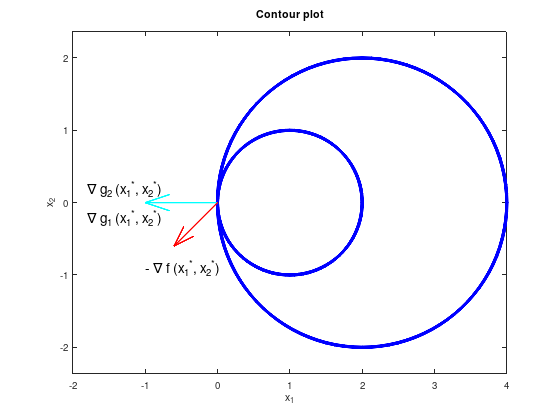RM03
Contents
RM03#
Consider the following constrained optimization problem:
\[\begin{split}
\begin{array}{llll}
\textrm{minimize} & f(x_1, x_2) &= x_1 + x_2 & \\
\textrm{subject to} & g_{1}(x_1, x_2) &= (x_1 - 1)^2 + {x_2}^2 - 1 &= 0, \\
& g_{2}(x_1, x_2) &= (x_1 - 2)^2 + {x_2}^2 - 4 &= 0, \\
\end{array}
\end{split}\]
with
\[\begin{split}
\nabla f(x_1, x_2) = \begin{pmatrix} 1 \\ 1 \end{pmatrix}, \quad
\nabla g_{1}(x_1, x_2) = \nabla g_{2}(x_1, x_2)
= \begin{pmatrix} 2(x_1 - 1) \\ 2 x_2 \end{pmatrix}.
\end{split}\]
The optimal point is \(\begin{pmatrix} {x_1}^{*} \\ {x_2}^{*} \end{pmatrix} = \begin{pmatrix} 0 \\ 0 \end{pmatrix}\) with \(f({x_1}^{*}, {x_2}^{*}) = 0\).
However, because \(\nabla g_{1}(x_1, x_2) = \nabla g_{2}(x_1, x_2)\) are not linear independent, the regularity constraint qualification (LICQ) is violated. The KKT conditions cannot be satisfied.
% Optimal point.
px = 0;
py = 0;
function circle (x, y, r)
t = 0:(pi / 50):2*pi;
x = r * cos (t) + x;
y = r * sin (t) + y;
plot (x, y, 'b', 'LineWidth', 4);
end
% Visualize constrained set of feasible solutions (blue).
circle (1, 0, 1);
hold on;
circle (2, 0, 2);
% Visualize scaled gradients of objective function (red arrow)
% and constraint functions (cyan arrows).
quiver (px, py, -1, 0, 'LineWidth', 2, 'c');
quiver (px, py, -0.6, -0.6, 'LineWidth', 2, 'r');
text (-1.0, -0.9, '- \nabla f ({x_1}^{*}, {x_2}^{*})', 'FontSize', 14);
text (-1.8, 0.2, '\nabla g_2 ({x_1}^{*}, {x_2}^{*})', 'FontSize', 14);
text (-1.8, -0.2, '\nabla g_1 ({x_1}^{*}, {x_2}^{*})', 'FontSize', 14);
axis equal;
xlim ([-2 4]);
xlabel ('x_1');
ylabel ('x_2');
title ('Contour plot');

Numerical experiment (only Matlab)#
function RM03()
% Nonlinear objective function.
fun = @(x) x(1) + x(2);
% Starting point.
x0 = [0, 0];
% Linear inequality constraints A * x <= b.
A = [];
b = [];
% Linear equality constraints Aeq * x = beq.
Aeq = [];
beq = [];
% Bounds lb <= x <= ub
lb = [];
ub = [];
% Call solver.
[x,fval,exitflag,output,lambda,grad,hessian] = fmincon (fun,x0,A,b,Aeq,beq,lb,ub,@nonlcon);
% Display interesting details.
exitflag % == 1 success
output
x % optimal solution
fval % function value at optimal solution
grad % gradient of fun at optimal solution
hessian % Hessian matrix of fun at optimal solution
lambda % Lagrange parameter
lambda.eqnonlin % lambda_1 and lambda_2
disp ('"="-Constraints')
[(x(1) - 1).^2 + x(2).^2 - 1; ...
(x(1) - 2).^2 + x(2).^2 - 4]
end
% Nonlinear constraint function for g_1.
function [c,ceq] = nonlcon(x)
c = 0;
ceq = [(x(1) - 1).^2 + x(2).^2 - 1; ...
(x(1) - 2).^2 + x(2).^2 - 4];
end
